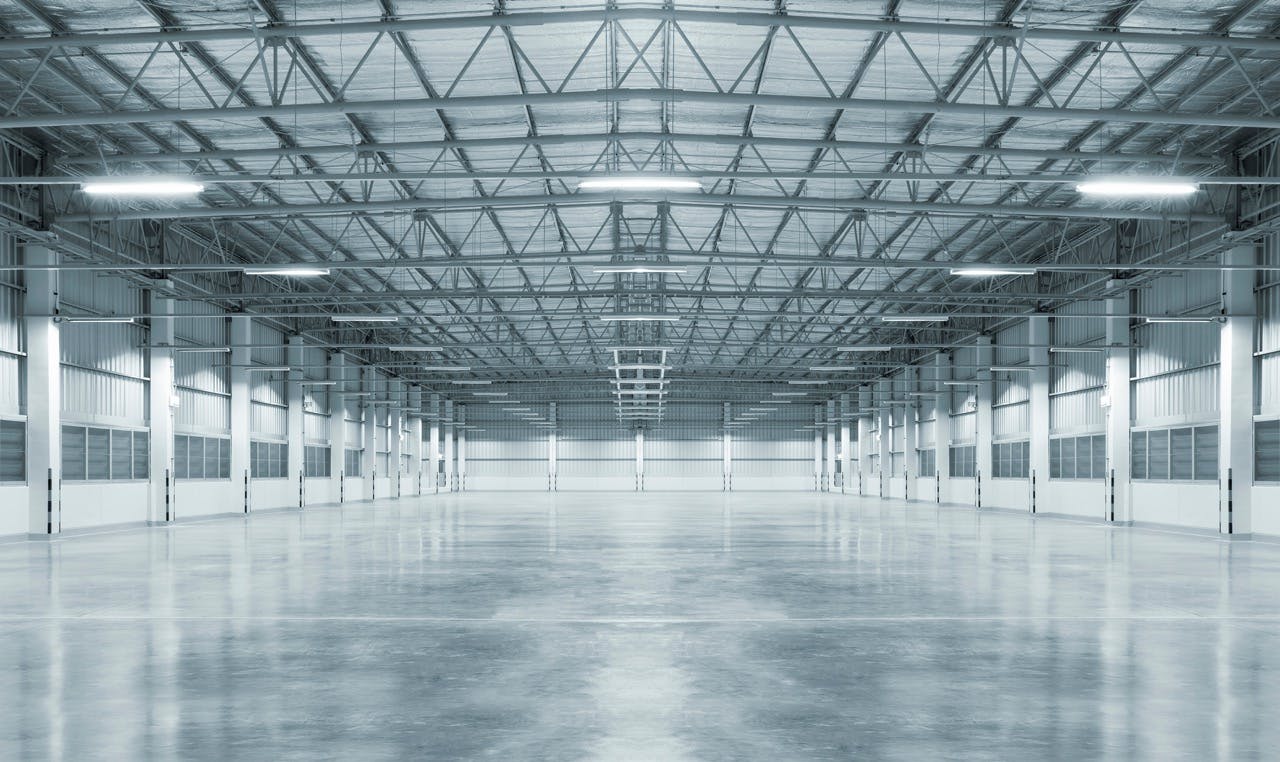Industrial Investment: Warehouse Buildings – what makes them an attractive CRE asset?
John Ledger

In the realm of real estate industrial investment, few assets embody stability and resilience like warehouses. These unassuming structures, often tucked away in industrial districts, have emerged as hidden gems within the commercial real estate (CRE) landscape. In our quest to navigate the complex world of CRE investments, it’s crucial to understand what defines a warehouse, why they stand as a beacon of stability, and the nuanced advantages and disadvantages that come with these concrete giants.
Warehouses, at their core, are the unsung heroes of the supply chain: colossal structures designed to store and manage the flow of goods and merchandise. From e-commerce giants housing millions of products to local distributors safeguarding inventory, these cavernous spaces serve as the beating heart of commerce. But they are more than just brick and mortar; they are the key to efficient logistics and a thriving global economy.
One might wonder what sets warehouses apart in the spectrum of CRE opportunities. The answer lies in their remarkable resilience. In a world of fluctuating markets and economic uncertainties, warehouses have consistently demonstrated their ability to weather the storms. This stability is rooted in their unwavering demand, driven by the rapid expansion of e-commerce, global trade, and the relentless need for storage and distribution space. In essence, warehouses are the backbone of a digitalized, globalized world.
However, like any industrial investment, warehouses come with their own set of pros and cons. On the positive side, they offer steady rental income, often through long-term leases with reputable tenants. The rising demand for e-commerce has increased the appeal of warehouses, making them a relatively low-risk venture in the CRE market. Yet, their size and specialized nature can also be a drawback, as finding suitable tenants and managing such vast properties can be a challenge. Moreover, the sector’s fortunes can be closely tied to economic fluctuations, potentially affecting vacancy rates and rental yields.
In this blog, we embark on a journey to uncover the secrets of warehouse investments in CRE. We will delve deeper into the dynamics that define these structures as exceptional industrial investment opportunities, explore strategies for maximizing returns, and navigate the potential pitfalls that lie in wait. By the time we conclude this exploration, you’ll be equipped with the knowledge and insights needed to harness the power of warehouse investments and make informed decisions in the ever-evolving landscape of commercial real estate. So, fasten your seatbelts, because the world of warehouse investments is both intriguing and rewarding, and it’s time to uncover its hidden treasures.
Understanding the Warehouse Industrial Investment
As we venture deeper into the realm of warehouse investments in commercial real estate (CRE), it becomes increasingly apparent that these structures are not a one-size-fits-all proposition, much like self-storage investment. Warehouses come in various shapes, sizes, and configurations, each catering to specific industries and market demands. Let’s explore some of the prominent types of warehouses and their unique characteristics:
1. Distribution Centers: The Engine of Supply Chain Efficiency
Distribution centers, often referred to as DCs, are the workhorses of the logistics world. Their primary function is to efficiently store, sort, and distribute goods to various destinations. Strategic positioning along transportation routes minimizes delivery times, making them indispensable for e-commerce giants and retail chains. Distribution centers are known for accommodating massive inventories and automated systems that streamline the movement of goods.
2. Manufacturing Operations: Where Creativity Meets Production
In contrast to distribution centers, manufacturing operations warehouses serve as hubs for production activities. These facilities house heavy machinery, assembly lines, and specialized equipment essential for manufacturing processes. They are designed to facilitate efficient production flows, making them vital for industries such as automotive, electronics, and food processing. Manufacturing warehouses may require unique infrastructure, including power supply and ventilation, to support specialized manufacturing needs.
3. Climate-Controlled Warehouses: Preserving Perishables and Sensitive Goods
Climate-controlled or cold storage warehouses are designed to maintain specific temperature and humidity conditions. They play a critical role in preserving perishable goods, pharmaceuticals, and sensitive materials. The controlled environment ensures the quality and safety of stored items, making them essential for industries like food and pharmaceuticals. These warehouses require advanced HVAC systems and insulation to maintain precise climate conditions.
4. Public vs. Private Warehouses: The Choice of Ownership
Beyond the functional distinctions, warehouses can be categorized based on their ownership and accessibility:
Public Warehouses: These are typically third-party facilities that offer storage and distribution services to multiple businesses on a rental basis. Public warehouses provide flexibility, scalability, and shared resources, making them suitable for companies seeking cost-effective solutions without the long-term commitment of owning or leasing their own space.
Private Warehouses: As the name suggests, private warehouses are owned or leased exclusively by a single business entity. They provide complete control and customization options, enabling companies to tailor the facility to their specific operational needs. Private warehouses are often chosen by large corporations with stable demand for storage and distribution services.
The Warehouse Market: Riding the Waves of Demand
Now, let’s shift our focus to the dynamic landscape of the warehouse market. The demand for warehouse space has experienced a remarkable surge in recent years, fueled by several key factors:
E-commerce Boom: The exponential growth of online shopping has led to an unprecedented demand for distribution centers. Additionally, E-commerce giants require vast warehouse networks to fulfill orders quickly and efficiently, spurring the development of mega distribution hubs.
Global Trade Expansion: International trade continues to thrive, necessitating the need for strategically located warehouses near ports and transportation hubs to facilitate the flow of goods.
Supply Chain Resilience: The lessons learned from disruptions like the COVID-19 pandemic have highlighted the importance of robust supply chains. Companies are increasingly seeking redundancy and diversification in their distribution networks, leading to increased demand for warehouse space.
Technological Advancements: Automation and technology are transforming warehouse operations, optimizing space utilization and enhancing efficiency. Investors are keen to capitalize on the potential for tech-driven warehouses.
Last-Mile Delivery: The race to deliver products faster has sparked interest in urban warehouses that serve as last-mile distribution centers, reducing delivery times for online orders.
Understanding the diverse landscape of warehouse types and the ever-evolving warehouse market dynamics is pivotal for making informed industrial investment decisions in CRE. In our next installment, we’ll delve deeper into the factors that drive warehouse investment success and strategies for navigating this thriving sector. Stay tuned as we continue our journey through the world of warehouse investments.
Benefits of Industrial Investment in Warehouses
Warehouse investments in commercial real estate (CRE) have gained immense popularity in recent years, and for good reason. These investments offer a multitude of benefits that attract savvy investors looking for stable and lucrative opportunities in the ever-evolving CRE landscape. Let’s explore some of the key advantages of investing in warehouses:
1. Steady Rental Income: Warehouses often come with long-term leases and high rentable blueprint, providing a consistent and reliable stream of rental income. Many businesses rely on these facilities to store and distribute their goods, making them committed tenants with a vested interest in maintaining the space.
2. Resilience to Economic Cycles: Warehouses have proven to be remarkably resilient to economic downturns. Their stability is driven by the fundamental need for storage and distribution space, which remains constant even in challenging economic times. This stability shields investors from the volatility that can affect other CRE sectors.
3. High Demand and Limited Supply: The demand for warehouse space continues to surge, driven by the growth of e-commerce, global trade, and the need for efficient logistics. However, the supply of well-located warehouses often lags behind, creating a favorable imbalance that can lead to increased rental rates and property appreciation.
4. Diverse Tenant Base: Warehouses cater to a diverse range of industries, from e-commerce and retail to manufacturing and logistics. This diversity in tenant base reduces the risk associated with relying on a single industry and ensures a broader pool of potential tenants. This, paired with low vacancy rates, means that there is generally low volatility and low tenant turnover.
5. Adaptability and Flexibility: Warehouse spaces can be adapted for various uses, allowing for flexibility in leasing. For example, a distribution center may be repurposed as a manufacturing facility if market conditions change. This adaptability enhances the long-term viability of warehouse investments.
6. Tax Benefits: Investors can benefit from tax advantages associated with warehouse investments. Depreciation allowances, cost segregation studies, and deductions for maintenance and improvements can help optimize the financial returns of these investments.
7. Technological Advancements: The integration of technology in warehouse operations, such as automation and data analytics, can improve efficiency, reduce operating costs, and enhance the overall value of the industrial investment. Additionally, warehouses are a durable asset class, meaning that they are irreplaceable through technological advancements in the future.
8. Last-Mile Opportunities: The growing demand for last-mile delivery services has led to an increase in urban warehouses. These strategically located facilities cater to the need for quick and efficient delivery in densely populated areas, making them highly sought after by e-commerce giants.
9. Portfolio Diversification: Including warehouse investments in a CRE portfolio can provide diversification benefits. Warehouses often exhibit different performance characteristics compared to other asset classes like office or retail properties, reducing overall portfolio risk.
10. Inflation Hedge: Real assets like warehouses can serve as a hedge against inflation. As the cost of goods and services rises, the value of warehouse properties and rental income may also increase, helping investors preserve their purchasing power.
Drawbacks of Warehouse Investment
Even though warehouses have a number of benefits, as with any investment, there are significant drawbacks in considering this asset class.
1. Geographical Sensitivity: The success of warehouse investments can be highly dependent on location. Investing in a warehouse in an area with declining demand or limited access to transportation infrastructure can result in lower returns or difficulty finding tenants.
2. High Initial Costs: Acquiring or constructing warehouses can involve substantial upfront costs, including land purchase, construction expenses, and infrastructure development. These costs can be a barrier to entry for some investors.
3. Tenant Concentration Risk: If a warehouse investment relies heavily on a single tenant or a small number of tenants, there is a higher risk of income disruption if a tenant decides not to renew their lease or faces financial difficulties.
4. Maintenance and Repairs: Warehouses, like any real estate property, require ongoing maintenance and periodic repairs. The cost of maintaining a large industrial facility can be significant – neglecting maintenance can lead to declines in property value.
5. Environmental Regulations: Warehouses, particularly those used for manufacturing or storing hazardous materials, may be subject to stringent environmental regulations. Moreover, compliance with these regulations can be costly and time-consuming.
6. Zoning and Regulatory Challenges: Zoning regulations and local government policies can affect the use and development of warehouse properties. Investors must navigate these regulations to ensure compliance and avoid potential legal challenges.
7. Infrastructure Costs: In some cases, significant infrastructure improvements may be necessary to make a warehouse property suitable for modern logistics operations. These costs can be substantial and impact the overall return on investment.
Other Key Considerations with Warehouse Investments
Now that you have a greater understanding of the pros and cons of acquiring a warehouse, you can focus on a few key factors that will determine whether your warehouse venture will be successful. These factors are as follows:
1. Location:
Strategic Placement: The old adage, “location, location, location,” holds particularly true in warehouse investments. Proximity to major highways, cities, airports, and railroads can significantly impact the efficiency of logistics operations. Being strategically positioned reduces transportation costs, enhances supply chain efficiency, and makes the warehouse more appealing to potential tenants.
2. Projected ROI:
Financial Feasibility: Determining the projected ROI is a cornerstone of any industrial investment decision. Typically targeted at 8-10% annually, this ROI goal necessitates a meticulous financial analysis. Investors should account for acquisition costs, ongoing operational expenses, and rental income to ascertain whether the investment aligns with their financial objectives and risk tolerance.
3. Tenant Profiles:
Stability and Growth: Selecting the right tenants is pivotal in warehouse investments. Ideal tenants are those with financial stability, a track record of credibility, and a trajectory of high projected growth. Industries such as e-commerce, manufacturing, and logistics, which have a consistent demand for warehouse space, are often prime targets for tenancy.
4. Net Rentable Square Footage (NRSF):
Precise Measurement: It’s essential to look beyond the basic square footage of the warehouse and delve into the Net Rentable Square Footage (NRSF). This metric, for example, accounts for common areas, hallways, and shared spaces, providing a more accurate representation of the space available for rent. Understanding NRSF is critical when determining rental income potential and optimizing the utilization of the property.
In the dynamic landscape of warehouse investments, a comprehensive assessment of these core considerations lays the groundwork for informed decision-making. Investors who carefully evaluate the location, projected ROI, tenant profiles, and NRSF are better equipped to navigate the complexities of the CRE market and leverage the potential of warehouse properties for long-term success.
To learn more about investment types, proptech, or commercial real estate trends, follow the AtlasX blog.


